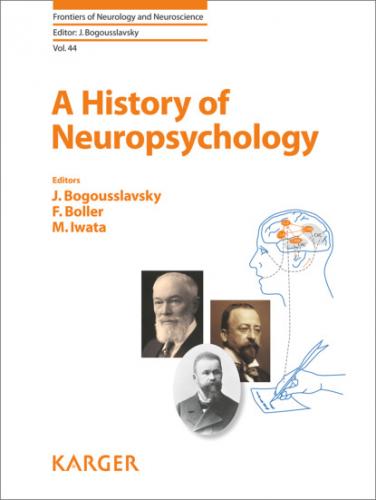36Benton AL: The “minor” hemisphere. J Hist Med Allied Sci 1972;27:5–14.
37Liepmann H: Das Krankheitsbild der Apraxie (motorischen Asymbolie) auf Grund eines Falles von einseitiger Apraxie. Monatsschr Psychiatr Neurol 1900;8:15–44; 102–132; 182–197.
38Hughlings-Jackson J: On the nature of the duality of the brain. Med Press Circ 1874;1:19–25, 41–49, 63–70. (Reprinted in Brain 1915;38:80–103.)
39Hughlings-Jackson J: Case of large cerebral tumour without optic neuritis and with left hemiplegia and imperception. Royal London Ophthalmic Hospital Reports 1876;8:434–444. Reprinted in Taylor J (ed): Selected writings of John Hughlings Jackson, vol 2. New York, Basic Books, 1958, pp 146–152.
40Dunn TD: Double hemiplegia with double hemianopsia and loss of geographical centre. Trans Coll Phys Phila 1895;17:45–56.
41Lenz GK: Beiträge zur Hemianopsie. Stuttgart, Germany, Hoffmannsche Buchdruckerei, 1905.
42Luys J: Recherches nouvelles sur les hémiplégies émotives. Encéphale. J Mal Ment Nerve 1881;1:378–398.
43Della Rocca M: The “other” localization: XIX century French neurophysiological models for the seat of the musical faculty in the brain. Rev Int Filosofia Psicol 2013;4:134–142.
44van Dalin O: Beräattelse om en dumbe, som kan siumga (On a mute who can sing). Kungliga Svenska Vetenskap Academiens nya Handlingar. Stockholm, Sweden, 1745, vol 6, pp 114–115.
45Johnson JK, Graziano AB, Hayward J: Historical perspectives on the study of music in neurology; in Rose FC (ed): Neurology of Music. London, Imperial College Press, 2010, pp 17–30.
46Knoblauch A: Ueber Störungen der musikalischen Leistungfähigkeit infolge von Gehirnläsionen [On disorders of musical ability as a result of brain lesions]. Deutsches Archiv für Klinische Medicin 1888;43:331–352.
47Johnson JK, Graziano AB: August Knoblauch and amusia: a nineteenth-century cognitive model of music. Brain Cogn 2003;51:102–114.
48Leurat F, Gratiolet P: (written by P. Gratiolet). Anatomie Comparée du Système Nerveux, Consideré des ses Rapports Avec l’Intelligence (vol. 2). Paris, J. B. Balliere et Fils, 1857.
49Ireland WW: Notes on left-handedness. Brain 1880;3:207–214.
50Parrot MJ: Sur le developpement du cerveau chez les enfants du premier age. Archives de Physiologie Normale et Pathologique (2nd Series) 1879;6:505–521.
51Ecker A: Zur Entwicklungsgeschichte der Furchen und Windungen der Grosshirn-Hemisphären im Foetus des Menschen. Archiv für Anthropologie 1868;3:212–223.
52Ireland WW: The Blot Upon the Brain: Studies in History and Psychology. New York, G. P. Putnam’s Sons, 1886.
53Bateman F: Aphasia or loss of speech in cerebral disease. J Ment Sci 1869;15:102–119; 367–392.
54Broca P: Sur le poids relatifs du deux hémisphères cérébraux et de leur lobes rontaux. Bulletins de la Société d’Anthropologie de Paris 1875;10:534–535.
55Assézat J: Recording of discussion of P. Broca, Sur le poids relativ des deux hémisphère cérébraux et de leurs lobes frontaux. Bulletins de la Société Anatomique de Paris 1875;10:535–536.
56Cunningham DJ: Right-handedness and left-brainedness. The Huxley lecture for 1902. J R Anthropol Inst Great Br Ireland 1902;32:273–296.
57Gall FJ, Spurzheim G: Anatomie et physiologie du système nerveux en général, et du cerveau en particulier: premier volume. Anatomie et physiologie du système nerveux en général, et anatomie du cerveau en particulier. Paris, F. Schoell, 1810.
58Vesalius A: (1543). De Humani Corporis Fabrica Libra Septum. Translated Excerpts in E. Clarke & C. D. O’Malley, The Human Brain and Spinal Cord: A Historical Study Illustrated by Writings from Antiquity to the Twentieth Century (pp 578–580). Berkeley, The University of California Press, 1968.
59Harris LJ: The corpus callosum and the question of hemispheric communication: an historical survey of theory and research; in Kitterle F (ed): Advances in Cerebral Laterality Research: Hemispheric Communication: Mechanisms and Models. New York, Erlbaum, 1995, pp 1–60.
60Harris LJ: Right-handers speak with the left hemisphere, left-handers with the right: the rise and fall of a neuropsychological hypothesis; in Barr WB, Bieliauskas LA (eds): The Oxford Handbook of History of Clinical Neuropsychology. Oxford Handbooks Online. Oxford, Oxford University Press, 2016.
61Nishitani N, Schurmann M, Amunts K, Hari R: Broca’s region: from action to language. Physiology 2005;20:60–69.
62Dubois J, Hertz-Pannier L, Cachia A, Mangin JF, Le Bihan D, Dehaene-Lambertz G: Structural asymmetries in the infant language and sensori-motor networks. Cerebral Cortex 2009;19:414–423.
63McCartney G, Hepper P: Development of lateralized behaviour in the human fetus from 12 to 27 weeks’ gestation. Dev Med Child Neurol 1999;41:83–86.
64Mori S, Oishi K, Faria AV: White matter atlases based on diffusion tensor imaging. Curr Opin Neurol 2009;22:362–369.
65Rogers LJ, Zucca P, Vallortigara C: Advantages of having a lateralized brain. Proc Biol Sci 2004;271(suppl 6):S420–S422.
66Rogers LJ, Vallortigara C, Andrews RJ: Divided Brains: The Biology and Behaviour of Brain Asymmetries. Cambridge, Cambridge University Press, 2013.
